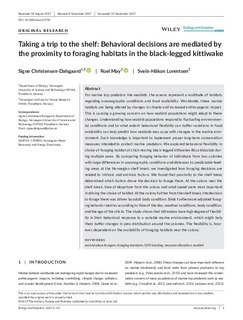| dc.contributor.author | Christensen-Dalsgaard, Signe | |
| dc.contributor.author | May, Roelof Frans | |
| dc.contributor.author | Lorentsen, Svein Håkon | |
| dc.date.accessioned | 2017-12-12T12:47:46Z | |
| dc.date.available | 2017-12-12T12:47:46Z | |
| dc.date.created | 2017-12-11T13:43:27Z | |
| dc.date.issued | 2017 | |
| dc.identifier.issn | 2045-7758 | |
| dc.identifier.uri | http://hdl.handle.net/11250/2470771 | |
| dc.description.abstract | For marine top predators like seabirds, the oceans represent a multitude of habitats regarding oceanographic conditions and food availability. Worldwide, these marine habitats are being altered by changes in climate and increased anthropogenic impact. This is causing a growing concern on how seabird populations might adapt to these changes. Understanding how seabird populations respond to fluctuating environmental conditions and to what extent behavioral flexibility can buffer variations in food availability can help predict how seabirds may cope with changes in the marine environment. Such knowledge is important to implement proper long-term conservation measures intended to protect marine predators. We explored behavioral flexibility in choice of foraging habitat of chick-rearing black-legged kittiwakes Rissa tridactyla during multiple years. By comparing foraging behavior of individuals from two colonies with large differences in oceanographic conditions and distances to predictable feeding areas at the Norwegian shelf break, we investigated how foraging decisions are related to intrinsic and extrinsic factors. We found that proximity to the shelf break determined which factors drove the decision to forage there. At the colony near the shelf break, time of departure from the colony and wind speed were most important in driving the choice of habitat. At the colony farther from the shelf break, the decision to forage there was driven by adult body condition. Birds furthermore adjusted foraging behavior metrics according to time of the day, weather conditions, body condition, and the age of the chicks. The study shows that kittiwakes have high degree of flexibility in their behavioral response to a variable marine environment, which might help them buffer changes in prey distribution around the colonies. The flexibility is, however, dependent on the availability of foraging habitats near the colony. central-place foragers, foraging decisions, GPS tracking, resource allocation, seabird | nb_NO |
| dc.language.iso | eng | nb_NO |
| dc.rights | Navngivelse 4.0 Internasjonal | * |
| dc.rights.uri | http://creativecommons.org/licenses/by/4.0/deed.no | * |
| dc.subject | central-place foragers | nb_NO |
| dc.subject | foraging decisions | nb_NO |
| dc.subject | GPS tracking | nb_NO |
| dc.subject | resource allocation | nb_NO |
| dc.subject | seabird | nb_NO |
| dc.title | Taking a trip to the shelf: Behavioral decisions are mediated by the proximity to foraging habitats in the black-legged kittiwake | nb_NO |
| dc.type | Journal article | nb_NO |
| dc.type | Peer reviewed | nb_NO |
| dc.description.version | publishedVersion | nb_NO |
| dc.subject.nsi | VDP::Matematikk og Naturvitenskap: 400::Zoologiske og botaniske fag: 480 | nb_NO |
| dc.source.pagenumber | 13 | nb_NO |
| dc.source.journal | Ecology and Evolution | nb_NO |
| dc.identifier.doi | 10.1002/ece3.3700 | |
| dc.identifier.cristin | 1525675 | |
| dc.relation.project | Andre: Seapop | nb_NO |
| dc.relation.project | Andre: Norwegian Water Resources and Energy Directorate | nb_NO |
| dc.relation.project | Andre: CEDREN | nb_NO |
| cristin.unitcode | 7511,2,0,0 | |
| cristin.unitname | Avdeling for terrestrisk økologi | |
| cristin.ispublished | true | |
| cristin.fulltext | original | |
| cristin.qualitycode | 1 | |

